Ever wanted to read about an innovative commercial production involving bullet time innovation, mobile photography, the use of camera motion in sequenced stills, and a guy called Jesus who is an Evangelist and a literal savior? If so, look no further, your prayers have been answered, because this post covers all of these bases and more.
I featured the innovative work of Paul Trillo a couple of times last year. You might remember him from his “Limitless” style journey through New York City, or his work on “Salience” which used super high speed video and chroma keying to interesting effect.
Paul is one of those rare guys combining artistic vision, business nouce and the ability to both conceptualize and execute extremely well to a client’s brief. His latest project had him partnered with both Nokia and Microsoft and uses a bullet time technique, but played off a little differently. Instead of panning around a subject in 360 degrees, the camera arcs along horizontal X axis, as a way for us to progress and explore the people around us.
Be warned – this is an innovative motion Paul and the team have come up with, and if you suffer from sea sickness or are reading this after coming back in from the pub having had a few sherries , you may experience an odd sensation. It kind of messes with your mind, which for me is wonderful. Consider yourself warned.
https://www.youtube.com/watch?v=LmDNjZM3Tu8
Paul has also provided a BTS video, detailing how they worked on capturing the shots which can be viewed here:
https://www.youtube.com/watch?v=hHVkNcvxMZM
I asked Paul a few questions about the project which I think we can all take a little something from to apply to both our own work, and business. The answer to how he was saved by Jesus is also contained within.
Me: Can you briefly describe from going from the brief set out by Nokia to how you arrived at the arc as a means to tell the story
Paul: Nokia Brand Labs originally approached me to do something with the frozen time or "bullet-time" effect using 50 of their Lumia 1020s. As we moved forward, the concept took many forms. We eventually landed on the idea of doing something that involved real people outside on the streets of New York City. I had been interested in capturing everyday moments rather than a premeditated dancing spectacle. I thought it could be interesting to use this technology to capture something honest and human.
Originally it was going to be the traditional 360º around a subject. However as we carried on, it sort of came to the point that doing the typical 360º rig didn't feel fresh or different enough. We thought of other ways we could configure a rig and turning it perpendicular seemed interesting to me. It gave a nice natural transition point. This arc rig also took advantage of the Lumia's form factor. There isn't any other camera that takes photos of this resolution that you could have crammed into such a tight amount of surface area. The thin device allowed us to stagger the phones.
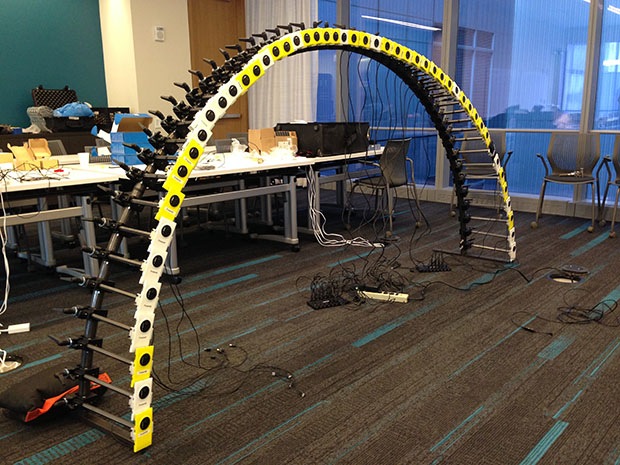
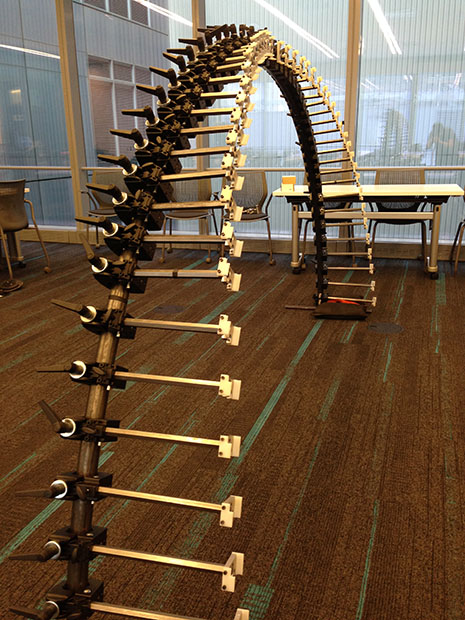
Me: Although we're watching a still frame, can you talk a little about the incorporation of motion into the piece? What feeling are you trying to convey to your audience through this motion?
Paul: As I was saying earlier, the arc gave an organic transition, so that the shots could be linked together in a seamless way. Since there were so many variables, I wanted to implement some type of regiment. Creating a camera motion that felt continuous. This allowed us to link and make connections between vastly different people and places. The piece is very much about being aware of the people in your surroundings. In New York, even though you're constantly surrounded by people, you tend to distance yourself from them. Yet the city ties everyone together whether you like it or not. If you actually stop and take a chance to meet those people, you'll realize that at any given moment you're standing next to an interesting person. If anything this project was a great excuse to meet people.
Me: What was the hardest part of this shoot to execute?
Paul: Without a doubt, making this rig 100% mobile. There is a reason why people do this in a studio. Typically, bullet-time synced cameras are tethered via USB but we didn't have that option. The phones needed to be connected to a WiFi network which ran off a gas generator. Also, the phones were running a camera app the entire day, so they needed to be powered constantly. This led to a lot of misfires for one reason or another. After all that is sorted, you need to find a way to move this thing around without risking the loss of a device. In DIY fashion, we had ended up strapping this massive arch rig to furniture dollys and simply pushed it around with many hands on deck. At first this process was pretty rough but by the end we were a well oiled machine.
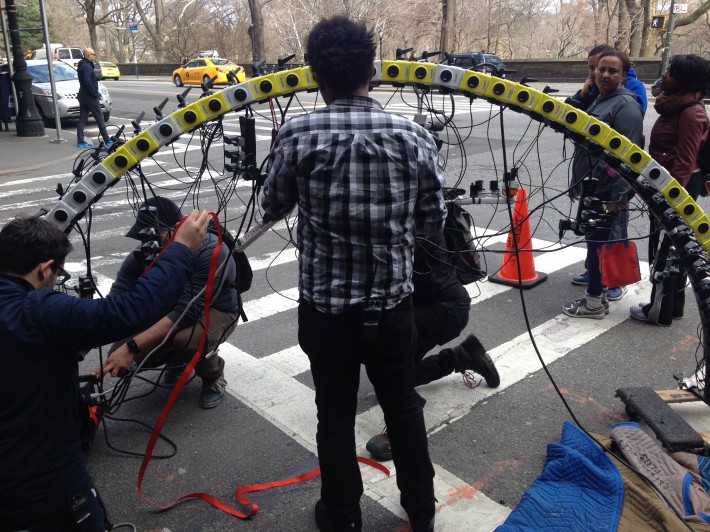
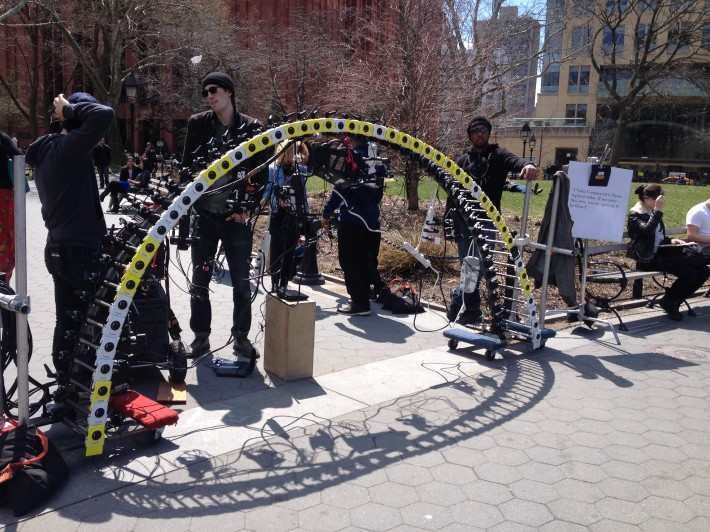
Me: Were there any unforeseen issue or challenge that came up you had to deal with and if so, how did you deal with it?
Paul: After we had agreed to the project, reality set in. We needed a way to get 50 devices to take a 41 megapixel photo at the same moment. Something that hadn't been done with a smart phone before.
Luckily, we met Jesus Aguilar, a Windows Evangelist, who developed the app for the Lumia and Surface. Jesus the evangelist was quite literally, our savior. After a few trial and error tests we managed to get the photos to be taken to be within a 0 - 20 millisecond latency. Although 0 milliseconds is the ideal, we're asking a lot from devices that weren't designed for this purpose.
The other issue was sequencing the images. All the photos were stored locally on the Lumias. There was no way of watching any playback on any of the takes either so it was a surprise when they were finally brought into post. We shot about 30,000 photographs which took a decent amount of time just to organize. Once everything was sorted, the sequences had a little jerkiness due to the slight difference in angles. As you can see in the behind the scenes video, the photos had to go through a process where they were slowed down and stabilized in order to get a playable sequence.
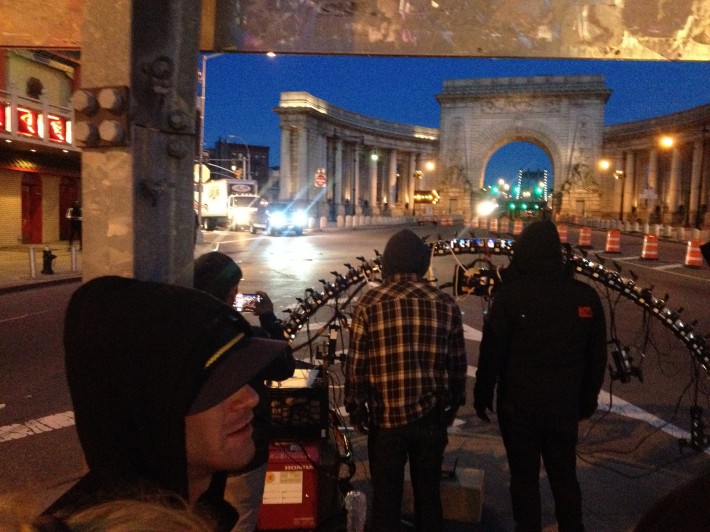
Me: You've developed a good relationship with Nokia. Can you impart any advice for anyone looking to reach out and connect with brands and how to establish relations with key brands they might wish to target and also, how you lay out the groundwork for developing solid relationships with those clients that lead to ongoing projects?
Paul: I've had a pretty unique relationship with Nokia (now Microsoft) since I've worked directly with someone at the Nokia Brand Labs. They function a little different then the rest of the company, specifically pushing for creative, non-traditional forms of advertising and branding. They're behind some of the best work to come out of Nokia. That really is key since it comes down to collaboration. Being able to work with the brief, deliver on expectations and then add a little surprise to the final product. I can't say there is one trick to establishing a good relationship with someone besides that it has to come natural. If you're open to collaborating and pushing each other to the limit of what can be done, then I'd say you're off to a good start.
_____________________________________________________________________________
I thought this project was a really interesting twist on a tried and tested stills technique (bullet time) with a different approach in the motion of the stills for different effect.
The integration of audio definitely added an additional layer to this form of multi media, and the fact they utilized an app that allowed them to achieve something “in the field” instead of relying on the luxury of the studio environment really speaks wonders to me of the innovation of the project, and the desire to try something new and make it work.
At a time when technology allows us to do so much and where it is changing so quickly, it becomes to easy to get tangled up in the mess of new tech developments and gear. This project exemplifies what you can do by having a clear vision, and working hard to “MacGyver” and invent what you need within a collaborative team to get great results.
Congrats to Paul and the team, looking forward to seeing what boundaries you’ll be pushing on the next project
Images courtesy of / Thanks to [Paul Trillo]







Cool concept but I did not think it was thought out visually. After about the third turn I felt motion sick, also I think they should have marked the transitions better maybe with object in the scene and some of the frame fought against the circle rotation.
was awesome in 10sec but 2min it so much. use it with care :)
The video makes the phones seem so low res.. I think it'd be better if they built the rig to hold the phones in a landscape position (instead, they cropped in to accommodate for the side cameras, in portrait) and then sped it up in an attempt to glide over the jitters.
Great concept but pretty awfully executed considering the goal of promoting the cameras
This is the small and inconspicuous street photography setup I've been looking for.
They may have had a great idea, but the presentation was nothing to write home about. Maybe should have gotten some input from a photographer/videographer too.
I'm seasick now
i had to skip and say hello again to my breakfast!
Looks like a poor rip off of Into the Mind from Sherpas Cinima. Epic - http://vimeo.com/54348266
And the original was bad enough.
not all people using fire, stole the blueprints to it.
also their explanation of how they got to it is very reasonable.
but this bullettime looks more likea 3D walk, in frozen time, much more interesting than just simple camera movement.
I made it three passes before skipping to the end. Interesting concept, but hard to watch for more than a couple passes at a time. Thanks for posting, it's always nice to see what's out there.
I like experiments... though I gotta say this one was a lot of effort for something that made me feel really dizzy. Roller coaster without the adrenaline
Very much like the 41x41 video Nokia released previously. An interesting concept - but the end result is nauseating.
that was really unpleasant to watch-_-
That's exactly how The Matrix did their bullet time as well. In fact, that's the reason it's called bullet time. https://www.youtube.com/watch?v=bKEcElcTUMk
ya and 15 yrs later with far better technology, people still cant do it as well as they did back then. half-assed post on bullet time effects just ruins it.
Cool idea in practice but not so much in reality. Can we say motion sickness! I wonder how the guy editing it felt about that?
Aye-bit of a tough watch! Still, I'm wondering how different rigs with all different shapes would work, like zig-zags etc. would make a crazy music video, or visuals at a rave/concert. Gifs too!
This was excellently done though, Makes you think about how much cool stuff happens in the blink of an eye/milliseconds/shitloads of shutterclicks. Like how the audio worked with it too.
Definitely high fives are in order for pulling it off, great job all round! :))